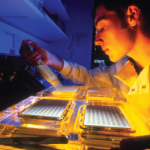Further study to define the role of rare variants in the risk of developing advanced AMD revealed an additional loss of function in C3 and CFI variants that, when linked with CFH, deactivates C3 in AMD.2 These data further show the direction of effect and mechanism of action underlying AMD.
To date, however, mapping rare variants for rheumatoid arthritis has not yet met with much success, said Dr. Raychaudhuri, adding that rare variant discovery in RA is more difficult than other autoimmune diseases.
Ongoing RA sequencing work by his group and by collaborators in the RA genetics community includes sequencing individuals with a high risk of disease burden. This includes sequencing individuals with RA who also have a sibling with RA, and patients with early onset disease or early age at onset of disease.
He said that further work will require larger sample sizes for adequately powered studies. “These studies will hopefully bring about novel discoveries in RA genetics and pathogenesis,” he said.
Discovery of Novel Disease

Dr. Aksentijevich
“Discovery of new disease-causing genes in rare patients may point to new pathways regulating immune and inflammatory responses,” said Ivona Aksentijevich, MD, staff scientist, Inflammatory Disease Section, National Institutes of Health, National Human Genome Research Institute, Bethesda, Md., in her presentation in which she shared work underway showing that whole exome sequencing (WES) can be used to identify novel disease-causing genes in both familial and sporadic cases with systemic inflammatory diseases.
As one type of next generation sequencing strategies, WES is a powerful and cost-effective tool—and one that works much faster than conventional approaches—to dissect the genetic basis of Mendelian phenotypes, or monogenic diseases, such as autoinflammatory diseases.
“New sequencing technologies along with new bioinformatic tools and the access to publicly available databases that provide exome sequences from over 100,000 human exomes allow identification of disease-causing genes in patients that present as sporadic cases, and that would otherwise be challenging for gene discoveries,” she said.
Illustrating the power of this next generation sequencing strategy, she highlighted nine new autoinflammatory diseases that have been discovered in the past two years (2014–2015) using WES, whereas it took 15 years (1997–2013) to identify 13 autoinflammatory diseases using conventional genetic approaches.
Despite the rapid increase in discovery of autoinflammatory diseases with the use of WES, she emphasized that many patients remain undiagnosed because of limitations with WES (captures only 80–90% of coding sequences, 5’ end of transcripts are typically poorly covered, and copy-number variations are not detected).

